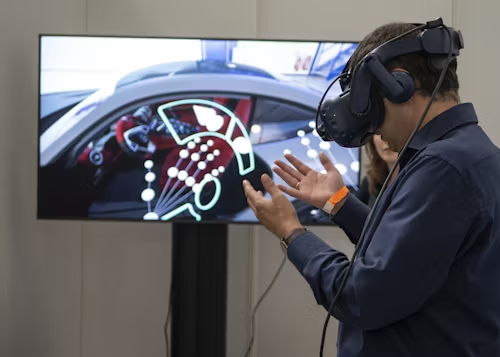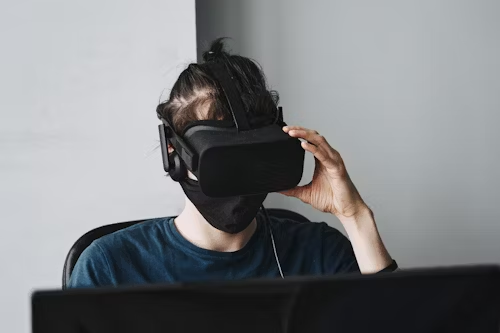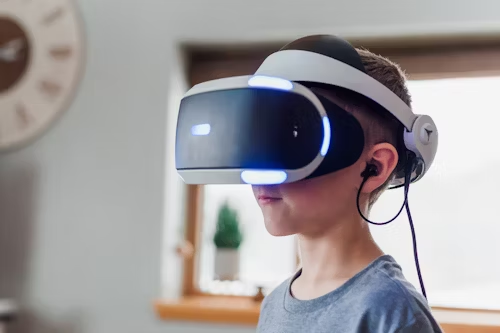Virtual reality has sparked interest once more. Virtual reality has arrived, presenting an ideal opportunity to acquire a VR headset. Virtual reality (VR) headsets have gained popularity in recent years, and you might already own one or consider getting one, especially as a gift for your child. After relative stagnation, investing in an immersive VR headset is worth considering. We’ve curated the Best VR Headset Guide to help you find the top-notch VR Headset.
VR Headsets
A VR headset is a wearable device worn over your eyes, resembling a pair of goggles. It allows you to experience a three-dimensional (3D) environment, enabling you to see all around you in virtual reality. But what exactly is virtual reality?
Virtual reality refers to a computer-generated 3D world in which users can immerse themselves in various environments, such as exploring an underwater realm or traveling to different countries, all from the comfort of their homes. When you wear a VR headset, you can immerse yourself in one of these virtual environments and actively engage with what’s happening.
Upon wearing the headset, the real world is blocked out, and instead, you are enveloped in the virtual reality world through lifelike images and videos. Everything you see in VR moves in sync with your movements, creating a sense of engagement in the experience.
VR headsets range from more straightforward, affordable models to sophisticated, high-tech versions. While each operates slightly differently, most come equipped with controllers to help navigate the virtual environment.
The Main types of VR Headsets:
- Tethered headsets necessitate physical connections to a computer (or PlayStation) using cables, exemplified by devices like the Sony PlayStation VR and HTC Vive Pro.
- Standalone headsets operate independently and do not require external connections, like the Meta Quest 2.
- Headsets that rely on mobile phones, like the Samsung VR, incorporate your smartphone into the headset by inserting it into a designated slot.
How VR Headsets Function
At its core, a VR headset is a sophisticated display device placed directly in front of your eyes. In the case of tethered headsets, such as those connected to a PC or game console, the connected device executes the task of rendering virtual environments. On the other hand, standalone wireless headsets like the Meta Quest 3 boast onboard processing power to handle this task independently.
To create a seamless virtual experience, VR headsets utilize external or internal sensors integrated into the headset to track your movements within physical space. This tracking lets the headset map your surroundings and adjust the virtual environment.
While traditional input devices like gamepads or keyboards can be used in VR, motion-tracking controllers are commonly employed to enhance immersion in three-dimensional environments. These controllers accurately capture your hand movements and gestures, allowing intuitive interaction with virtual objects and environments.
When evaluating VR headsets, we focus on several key factors: ergonomics, immersion, and controls. While it’s relatively easy to assemble a VR headset with a mobile display and basic elastic straps, crafting a balanced, comfortable device that remains wearable for extended periods requires skill.
Our ergonomics assessment is straightforward: How long can the headset be worn before discomfort sets in? The most ergonomic devices, such as the Quest 3, can typically be worn for an hour or more without issue. Headsets with heavier PC hardware often become uncomfortable after just 15 minutes, and such models are not included in this guide.
Immersion is achieved through high-resolution screens with fast refresh rates, ensuring sharp and smooth visuals. The field of view is also crucial, as it determines how much of your surroundings can be covered by the VR screens. A narrow field of view can create a limited sense of presence, whereas a wider field enhances the feeling of being transported to a virtual world. We assess immersion by testing popular games like Superhot, Beat Saber, and Pistol Whip on each headset to gauge the level of immersion experienced.
Controllers play a vital role in the VR experience; the best ones fit naturally in your hands while offering precise tracking. While Meta’s touch controllers have set the industry standard, we also evaluate innovative designs such as Valve’s finger-tracking gamepads. Our assessment considers factors such as comfort during extended gameplay, resistance to sweat, and the accuracy of positional tracking.

Best VR Headset Guide: The 5 Ideal High-Tech Versions!
Meta Quest 3
Top Pick for Overall VR Experience
The Meta Quest 3 surpasses its predecessor in every aspect, making it the ultimate choice for VR enthusiasts. With improved comfort, higher-quality screens, and full-color mixed-reality cameras, this headset offers an unparalleled immersive experience. While priced at $500, its enhanced hardware and optics ensure long-term satisfaction in the VR world.
Powered by Qualcomm’s Snapdragon XR2 Gen 2 chip, the Quest 3 boasts double the graphics power of its predecessor, which is evident in games like Red Matter 2 with updated textures akin to PC VR. Its new displays deliver an impressive resolution of 2,064 by 2,208 pixels per eye, surpassing even the PlayStation VR2. The mixed-reality cameras also enable seamless transitions between the virtual and real worlds, facilitating tasks like responding to messages or integrating room-scale gameplay.
Beyond solid VR capabilities, the Quest 3 provides a glimpse into the future of mixed reality. While not as advanced as Apple’s Vision Pro, it offers versatility by supporting PC connectivity for high-quality VR experiences.
Pros:
- Sharp screens and lenses
- Compact design compared to Quest 2
- Improved performance
- Mixed reality cameras enhance real-world visibility
- Glasses-friendly design
Cons:
- Higher price tag than its predecessor
- Initial storage is limited to 128GB
- No battery life improvements
Apple Vision Pro
Leading Next-Generation VR/AR Headset
The Apple Vision Pro marks a significant leap forward in VR and AR, akin to the transformative impact of the iPod and iPhone in their respective domains. Priced at $3,500, it’s a bold venture by Apple to redefine spatial computing. While its cost may deter many, its comfort and performance are not without flaws; the Vision Pro represents a groundbreaking advancement in an otherwise stagnant VR industry.
Pros:
- Exceptional Micro-OLED screens
- Intuitive gesture controls
- Immersive Spatial Audio
- Astoundingly realistic immersive video experience
Cons:
- High price point
- visions exhibit significant bugs
- Relatively heavy compared to other headsets
- External battery is cumbersome and has a limited lifespan
- Limited availability of native vision apps
Meta Quest 2
Top Affordable VR Headset
Even years after its debut, the Meta Quest 2 remains the go-to choice for budget-conscious VR enthusiasts. Priced at a competitive $250, it offers an entirely standalone VR experience, ensuring comfort during extended usage sessions. With an extensive library of titles and Meta’s reliable motion controllers included, the Quest 2 provides an accessible entry point into the world of VR without breaking the bank.
Equipped with fast-switching LCDs boasting a resolution of 1832×1920 per eye and a smooth 90Hz refresh rate, the Quest 2 delivers impressive visuals considering its mobile hardware setup. While its field of view measures around 90 degrees, various face pads can be utilized to enhance the viewing experience. The optional Elite head strap,
priced at $49 for the standalone version or $129 for the version with a built-in battery and case, offers added comfort for extended usage.
While the Quest 2 may not offer the pinnacle of VR experiences, its affordability and versatility make it an ideal choice for entry-level users.
Pros:
- High-resolution screens
- Powerful hardware
- Standalone VR experience
- Desktop VR compatibility
- Competitive price point
Cons:
- Limitations in standalone game performance due to mobile hardware
- The initial absence of a 90Hz refresh rate
- Fit adjustment may be cumbersome
PlayStation VR 2
Top Console VR Headset
The PlayStation VR2 stands out as one of the finest headsets we’ve evaluated. Boasting dual 2K OLED HDR screens, it effectively delivers 4K-quality visuals. It is remarkably comfortable to wear and introduces innovative features like eye tracking and headset haptics, providing an immersive experience. Most notably, the PS VR2 offers high-quality virtual reality gaming without requiring an expensive gaming PC – connect it to a PlayStation 5.
However, there are several factors to consider. Priced at $550, the PS VR2 is more expensive than the PS5. Additionally, the availability of titles for the platform remains to be determined, with only a handful of exclusives like Horizon VR and Gran Turismo 7 available at launch. Despite these challenges, it remains the most accessible route to premium VR experiences, significantly improving over its predecessor, the original PS VR.
Pros:
- Outstanding OLED displays
- Exceptional comfort
- Immersive headset haptics
- Reliable Sense Controllers
Cons:
- High launch price
- Limited availability of new titles
- Uncertain long-term development

Valve Index VR Kit
Premium PC VR Headset for Enthusiasts
Valve’s Index kit remains a top-tier choice for gamers seeking an unparalleled VR experience. Priced at $999, the Index package includes the headset, Valve’s innovative finger-tracking controllers, and two SteamVR base stations. Despite the emergence of higher-resolution alternatives in recent years, the Index maintains its position as a formidable contender, boasting a resolution of 1,440 by 1,600 pixels, an impressive 144Hz refresh rate, and an expansive 130-degree field of view. While some may prioritize resolution, the Index’s smoother display and broader field of view are more captivating than most consumer headsets.
As a SteamVR product, the Index requires two sensors at opposite ends of your play space and remains tethered to your PC. However, the inconvenience of this setup is offset by the enhanced refresh rate and precise tracking it offers. Although more user-friendly than the Quest 2, enthusiasts will likely tolerate these minor inconveniences for superior VR immersion.
Valve’s finger-tracking controllers are a standout feature, featuring a secure strap that ensures they stay in place during gameplay. While they excel in titles like Half-Life: Alyx, it’s regrettable that other VR experiences haven’t fully capitalized on their capabilities.
Pros:
- Impressive 144Hz refresh rate and 130-degree field of view
- Exceptional finger-tracking controllers
- Outstanding performance
Cons:
- Requires installation of room sensors
- Wired connection to PC
Best VR Headset for Full Body Tracking :
In the Quest for comprehensive body tracking in VR, while awaiting the arrival of a standout haptic VR bodysuit, most Steam VR-compatible PC headsets offer viable options. The HTC Vive Pro 2 and Valve Index utilize room-tracking sensors to accurately map your body movements, providing more effective tracking than their competitors. For enhanced coverage, accessories like HTC Vive Trackers can be attached to wrist and leg straps and belts.
While the Meta Quest 3 lacks built-in body tracking solutions, you can incorporate Vive trackers with a PC to simulate a Steam VR headset. However, it’s important to note that only a limited number of experiences, such as VRChat, currently support full body tracking.
Unfortunately, no dedicated body tracking solutions are available for PlayStation VR and VR2. However, there is intrigue surrounding the potential of Mocopi body trackers from the company, although they have primarily been announced in Japan.
Conclusion:
The Meta Quest 3 provides exceptional standalone VR experiences at $500, while Apple’s Vision Pro, priced at $3,500, ventures into the fusion of VR and augmented reality (AR). For owners of the original Quest, upgrading may prove worthwhile. Although the Vision Pro may be outside reach for most consumers, it offers valuable insights into the future trajectory of the VR category. With comprehensive testing and reviews of all major players in the VR market, this buyer’s guide helped you select the ideal VR headset to meet your requirements.



